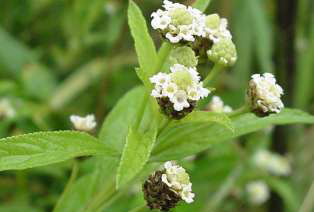Fact sheet about Lippia javanica
Distribution and habitat
Lippia javanica is a woody shrub found throughout eastern and southern Africa, usually on forest fringe, grasslands on hillsides and banks of streams. In Tanzania, it can be found in Musoma district, Serengeti, Seronera –Soit Ayai, Arusha district, little Meru, Mt. Kisimiri, Ngurudoto area, Arusha National Park, Momela, Lushoto district, Kwai Valley. In Kenya, it can be found in Cherangani Hills, Kiambu district, Masai district and on the Naraok- Naivasha road. In southern Africa, Lippia javanica is found from Eastern Cape through to Botswana, Swaziland, Mozambique and Malawi. The species is drought resistant and can grow in a variety of soil types.
Flowering and fruiting habits
Lippia javanica is a 1 to 2 m high woody shrub that stands erect and is multi-stemmed. The stems are heavily branched and appear square when observed in a cross section. The leaves are elliptical, 3-4 cm in length with sunken veins, when crushed they give off a lemon like odour. The leaf margins are dentate, lightly toothed and hairy on both sides. The flowers are creamy white, clustered together in a dense round spike at the apex of the stem. Flowers are creamy white, densely clustered together, in round spikes. Flowers are inflorescence 1-3 per axils, globose to hemispherical or oblong to ovoid, 0.5-2 cm. Bracts 3 x 2 mm, broadly ovate; calyx 2-lobed, 2mm long; tube 3-4 mm long, puberulous and glandular above corolla tube 4 mm long.
Uses other than pesticidal
Medicinal – Leaves are medicinal and used as a herbal tea to treat coughs, aching muscles and sometimes to treat malaria. Skin disorders, such as heat rash and other rashes, as well as scratches, stings and bites and parasites such as lice and scabies can be treated with the Lippia javanica leaves mixed in hot water tea that is usually cooled and then applied like a lotion. Leaves, twigs and sometimes roots can be used.
Cosmetics – Masai people use its red ointment to decorate their bodies. Gardeners use it in pot- pourri and some people use it to make perfume.
Propagation and cultivation
Lippia javanica grows easily from seeds and from cuttings too. It grows relatively fast and prefers sunny areas. Lemon bush is not very particular and seems to do well in most soil types.
Seed collection & Storage
Seeds are tiny nuts and brown in colour. Collection of fruits at onset of natural dispersion. After harvesting, fruits are placed in open trays at room temperature to dry and open to release the seeds. Seeds are separated from the fruits by light threshing and hand sorting.
Parts used
Leaves
Preparation
Dry and grind
Essential oil
Often layered whole plants in storage, occasional stirring to release volatile compounds
Uses
Can be used both pre and post-harvest
Target organisms
Against broad range of insects
Commonly known as the fever tea tree or lemon bush. L. javanica is a small woody shrub normally growing 1-2 m high. It can be found throughout eastern and southern Africa usually on forest fringes, hillside grassland or stream banks. It characteristically has squared stems and produces densely grouped white flowers.
The leaves are used for medicinal purposes to treat coughs and muscle ache. These are often taken as an herbal tea but some also burn the leaves and stem and inhale the smoke which is produced. In some countries it is also possible to purchase commercial medicines containing L. javanica extracts.
It is also used in both pre- and post- harvest pest management and is effective in the control of ecto-parasites on livestock.
The species tends to exhibit high concentrations of essential oils but the exact chemistry of this is found to vary greatly both within and between natural plant populations. The chemistry of the plant is also affected by geography and season. Because of this dramatic variation which can be seen between plants it is recommended that farmers pre-trial before wider application.

